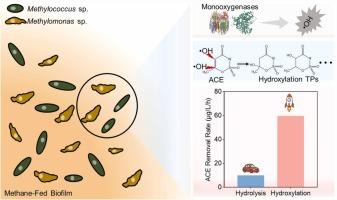羟化介导的乙酰磺胺降解甲烷生物膜:一个新的和有效的生物降解途径
IF 11.3
1区 环境科学与生态学
Q1 ENGINEERING, ENVIRONMENTAL
引用次数: 0
摘要
安赛蜜(ACE)是一种持久性有机污染物,经常在各种水生环境中被检测到,但由于其固有的生物降解缓慢,其环境修复仍然具有挑战性。在这里,我们揭示了一种高效的ACE去除策略,使用甲烷喂养的生物膜,实现降解率比传统活性污泥系统高近六倍。对转化产物(TPs)和毒性谱的综合分析表明,羟基化是促进ACE深度降解的重要而有效的生物降解途径。微生物群落分析、甲烷中断实验和纯培养研究表明,有氧甲烷氧化菌甲基球菌和甲基单胞菌是ACE降解的关键参与者。宏基因组学和元转录组学分析表明,这些甲烷氧化菌在生物膜群落中具有高水平的颗粒甲烷单加氧酶(pMMO)和细胞色素P450单加氧酶(CYP450)基因表达。酶抑制试验,结合TP分析,证实pMMO和CYP450催化羟基化驱动的ACE降解。清除实验进一步表明,通过pMMO和CYP450的催化活性产生的羟基自由基(•OH)是ACE羟基化途径的重要介质。这些发现首次证明了羟化介导的ACE在甲烷生物膜系统中的降解,为去除废水中的顽固性有机污染物提供了一种有前途的可持续方法。本文章由计算机程序翻译,如有差异,请以英文原文为准。

Hydroxylation-mediated acesulfame degradation within a methane-fed biofilm: a novel and efficient biodegradation route
Acesulfame (ACE), a persistent organic pollutant, is frequently detected across diverse aquatic environments, yet its environmental remediation remains challenging due to the inherently slow biodegradation. Here, we unveil a highly efficient ACE removal strategy using a methane-fed biofilm, achieving degradation rates nearly six times higher than those of conventional activated sludge systems. Comprehensive analyses of transformation products (TPs) and toxicity profiles revealed that hydroxylation emerged as an important and effective biodegradation pathway, promoting deep ACE degradation. Microbial community analysis, methane interruption experiments and pure culture studies implicated aerobic methanotrophs Methylococcus sp. and Methylomonas sp. as key players in ACE degradation. Metagenomic and metatranscriptomic analyses demonstrated that these methanotrophs exhibited high expression levels of particulate methane monooxygenase (pMMO) and cytochrome P450 monooxygenase (CYP450) genes within the biofilm community. Enzyme inhibition assays, combined with TP profiling, confirmed that pMMO and CYP450 catalyze the hydroxylation-driven degradation of ACE. Scavenging experiments further suggested that hydroxyl radicals (•OH) generated through the catalytic activity of pMMO and CYP450 are crucial mediators in the ACE hydroxylation pathway. These findings provide the first evidence of hydroxylation-mediated ACE degradation in a methane-fed biofilm system, offering a promising and sustainable approach for the removal of recalcitrant organic contaminants from wastewater.
求助全文
通过发布文献求助,成功后即可免费获取论文全文。
去求助
来源期刊

Journal of Hazardous Materials
工程技术-工程:环境
CiteScore
25.40
自引率
5.90%
发文量
3059
审稿时长
58 days
期刊介绍:
The Journal of Hazardous Materials serves as a global platform for promoting cutting-edge research in the field of Environmental Science and Engineering. Our publication features a wide range of articles, including full-length research papers, review articles, and perspectives, with the aim of enhancing our understanding of the dangers and risks associated with various materials concerning public health and the environment. It is important to note that the term "environmental contaminants" refers specifically to substances that pose hazardous effects through contamination, while excluding those that do not have such impacts on the environment or human health. Moreover, we emphasize the distinction between wastes and hazardous materials in order to provide further clarity on the scope of the journal. We have a keen interest in exploring specific compounds and microbial agents that have adverse effects on the environment.
 求助内容:
求助内容: 应助结果提醒方式:
应助结果提醒方式:


